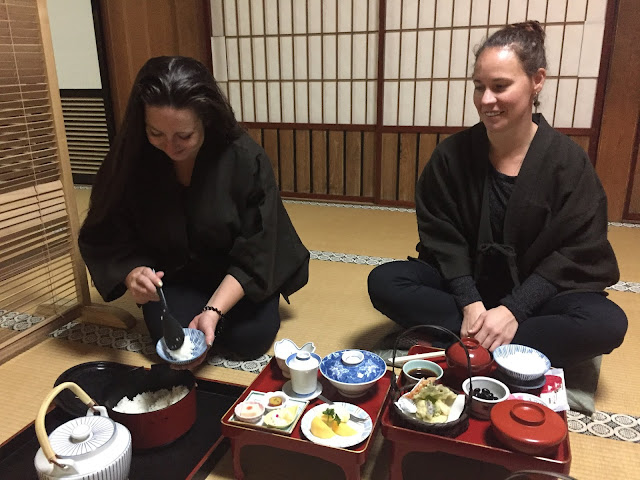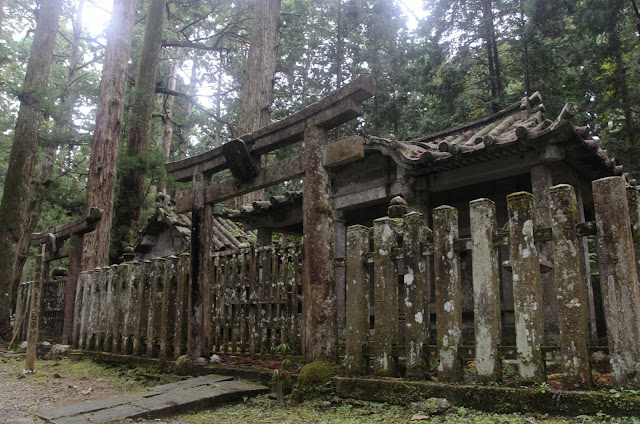 |
| Train ride to Koyasan |
 |
| Train ride to Koyasan |
 |
| Shojoshinin (清浄心院) |
 |
| Shojoshinin (清浄心院) |
 |
| Shojoshinin (清浄心院) |
 |
| Shojoshinin (清浄心院) |
 |
| Shojoshinin (清浄心院) |
 |
| Shojoshinin (清浄心院) |
 |
| Shojoshinin (清浄心院) |
 |
| Shojoshinin (清浄心院) |
 |
| Shojoshinin (清浄心院) |
 |
| Shojoshinin (清浄心院) |
 |
| Shojoshinin (清浄心院) |
 |
| Shojoshinin (清浄心院) |
 |
| Shojoshinin (清浄心院) |
 |
| Shojoshinin (清浄心院) |
There are a lot of temples in Koyasan that you walk though along the side of the road. Karukayado (苅萱堂) is just on the side of the road with so many flags on the outside.
 |
| Karukayado (苅萱堂) |
Jofukuin (成福院) was one of the most noticeable temple and had a small museum section in the pagoda. There was a shrine and an underground section where you walk int he dark with shrines lit up underground. Display cases held religious or historic items from wars.
 |
| Jofukuin (成福院) |
 |
| Jofukuin (成福院) |
 |
| Jofukuin (成福院) |
 |
| Jofukuin (成福院) |
 |
| Jofukuin (成福院) |
Kongobuji (金剛峯寺) was one of the larger temples in town with a large open area in front of the temple.
 |
| Kongobuji (金剛峯寺) |
 |
| Kongobuji (金剛峯寺) |
 |
| Kongobuji (金剛峯寺) |
 |
| Kongobuji (金剛峯寺) |
 |
| Kongobuji (金剛峯寺) |
 |
| Kongobuji (金剛峯寺) |
 |
| Kongobuji (金剛峯寺) |
 |
| Kongobuji (金剛峯寺) |
 |
| Rokujino kane (高野山金剛峯寺 六時の鐘) |
Danjō-garan (壇上伽藍), or Garan, was one of the first complexes built by Kobo Daishi in Koyasan. It has been rebuilt a few times after being destroyed by fire. The 20 temple buildings surround the main large pagoda. A large red gate sits at the main entrance to the temple. Smaller pagodas are scattered around the temple grounds.
The pagoda is really tall and you can enter it and walk around the statue in the center. Nearby a famous tree is gated off. This tree is said to be the reason why the founder chose this location to start the temple.
I small pagoda had a wheel you could turn. I am not really sure the point of spinning the wheel but I think you are supposed to make a wish and spin it all the way around.
The temple pagoda and gate are lit up at night and there are very few people around so it is very quiet and serene. Some flying squirrels were calling from the large trees by the temple.
The gate has four statues, one at each corner depicting very different personalities including a warrior and a scholar.
 |
| Danjō-garan (壇上伽藍) |
 |
| Danjō-garan (壇上伽藍) |
 |
| Danjō-garan (壇上伽藍) |
 |
| Danjō-garan (壇上伽藍) |
 |
| Danjō-garan (壇上伽藍) |
 |
| Danjō-garan (壇上伽藍) |
 |
| Danjō-garan (壇上伽藍) |
 |
| Danjō-garan (壇上伽藍) |
 |
| Danjō-garan (壇上伽藍) |
 |
| Danjō-garan (壇上伽藍) |
 |
| Danjō-garan (壇上伽藍) |
 |
| Danjō-garan (壇上伽藍) |
 |
| Danjō-garan (壇上伽藍) |
 |
| Danjō-garan (壇上伽藍) |
 |
| Danjō-garan (壇上伽藍) |
 |
| Danjō-garan (壇上伽藍) |
 |
| Danjō-garan (壇上伽藍) |
 |
| Koyasan Okunoin Omotesando Ichinohashi (高野山 奥の院 表参道 一の橋) |
 |
| Koyasan Okunoin Omotesando Ichinohashi (高野山 奥の院 表参道 一の橋) |
Graves and gates are set amongst the trees and shaded by the thick canopy overhead. Small paths extend from the main train to take you to other sections of the graveyard.
 |
| Koyasan Okunoin Omotesando Ichinohashi (高野山 奥の院 表参道 一の橋) |
 |
| Koyasan Okunoin Omotesando Ichinohashi (高野山 奥の院 表参道 一の橋) |
 |
| Koyasan Okunoin Omotesando Ichinohashi (高野山 奥の院 表参道 一の橋) |
 |
| Koyasan Okunoin Omotesando Ichinohashi (高野山 奥の院 表参道 一の橋) |
 |
| Koyasan Okunoin Omotesando Ichinohashi (高野山 奥の院 表参道 一の橋) |
 |
| Koyasan Okunoin Omotesando Ichinohashi (高野山 奥の院 表参道 一の橋) |
 |
| Koyasan Okunoin Omotesando Ichinohashi (高野山 奥の院 表参道 一の橋) |
 |
| Koyasan Okunoin Omotesando Ichinohashi (高野山 奥の院 表参道 一の橋) |
 |
| Koyasan Okunoin Omotesando Ichinohashi (高野山 奥の院 表参道 一の橋) |
 |
| Koyasan Okunoin Omotesando Ichinohashi (高野山 奥の院 表参道 一の橋) |
 |
| Koyasan Okunoin Omotesando Ichinohashi (高野山 奥の院 表参道 一の橋) |
They give night tours of the graveyard and you can here flying squirrels high up in the trees and I am sure if you are lucky and in the right season owls would be calling in this ancient forest. You can also just walk the graveyard for free at night like I did to avoid being one of the 30 some people in the tour.
 |
| Koyasan Okunoin Omotesando Ichinohashi (高野山 奥の院 表参道 一の橋) |
 |
| Japanese Toad |
 |
| Japanese Toad |
 |
| Koyasan Okunoin Omotesando Ichinohashi (高野山 奥の院 表参道 一の橋) |
The huge Daimon Gate (金剛峯寺大門) is on the far side of town from the temple we stayed at. I visited it at night in the fog when it was very difficult to see it well. Nearby the gate is a trail with tori gates up the hill. Unfortunately the typhoon damage from weeks ago still caused this trail to be closed.
 |
| Daimon Gate (金剛峯寺大門) |
Hiking from Manizan (摩尼山) to Yoryusan (楊柳山) is a lovely day hike. You walk along a dirt trail to two mountain peaks. The peaks don't have a view but are marked with small shrines. The forest is lush green and a mix of evergreens and deciduous trees.
 |
| Hiking from Manizan (摩尼山) to Yoryusan (楊柳山) |
 |
| Hiking from Manizan (摩尼山) to Yoryusan (楊柳山) |
 |
| Hiking from Manizan (摩尼山) to Yoryusan (楊柳山) |
 |
| Hiking from Manizan (摩尼山) to Yoryusan (楊柳山) |
 |
| Hiking from Manizan (摩尼山) to Yoryusan (楊柳山) |
 |
| Hiking from Manizan (摩尼山) to Yoryusan (楊柳山) |
 |
| Hiking from Manizan (摩尼山) to Yoryusan (楊柳山) |
 |
| Tokugawa Clan Mausoleum (徳川家霊台) |
 |
| Tokugawa Clan Mausoleum (徳川家霊台) |
 |
| Tokugawa Clan Mausoleum (徳川家霊台) |
 |
| Tokugawa Clan Mausoleum (徳川家霊台) |
 |
| Tokugawa Clan Mausoleum (徳川家霊台) |
 |
| Tokugawa Clan Mausoleum (徳川家霊台) |







No comments:
Post a Comment